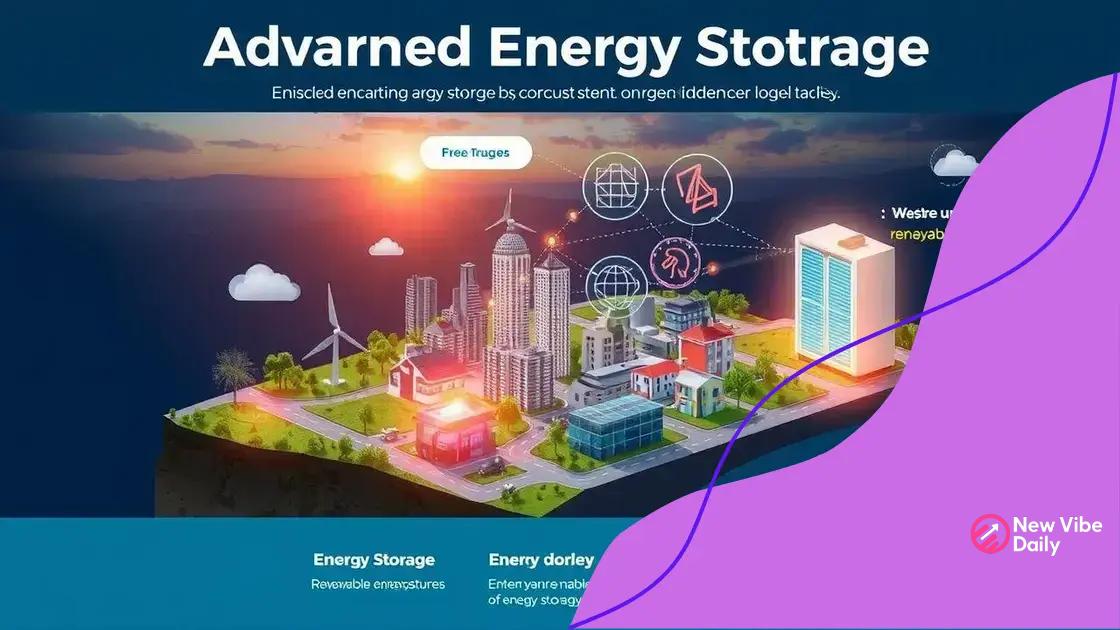The future of energy storage solutions is bright

The future of energy storage solutions significantly enhances the integration of renewable energy, improves reliability, reduces carbon emissions, and empowers communities towards sustainable energy practices.
The future of energy storage solutions is evolving rapidly and has the potential to transform how we consume energy. Have you thought about how these innovations could impact your everyday life? Let’s delve into what the future holds.
Understanding energy storage solutions
Understanding energy storage solutions is essential as we move towards a more sustainable future. These systems are designed to store energy for later use, which can help balance supply and demand.
Types of Energy Storage
There are several types of energy storage technologies available today. Each type has its benefits and use cases. Here are some of the most common:
- Batteries: Lithium-ion and lead-acid batteries are widely used for various applications.
- Flywheels: These devices store energy in the form of rotational kinetic energy, allowing for rapid release.
- Pumped Hydro: This method uses water reservoirs to store and release energy through gravity.
- Compressed Air: Air is compressed in underground caverns and released to generate power.
Each technology plays a crucial role in different scenarios. Batteries, for instance, are great for household solar energy systems, whereas pumped hydro is effective for large-scale storage needs.
Benefits of Energy Storage Solutions
The advantages of adopting energy storage solutions are significant. These systems provide flexibility and resilience to energy grids. They also help in integrating renewable energy sources into the grid more efficiently. With energy storage, surplus energy can be accumulated and used during peak demand times.
Furthermore, energy storage can reduce operational costs, enhance energy security, and contribute to lower carbon emissions. This aligns with global goals for sustainability.
As we continue to innovate, understanding these energy storage solutions becomes even more important. The future holds exciting possibilities that could change how we think about energy consumption and generation.
Innovative technologies shaping the future
Innovative technologies are rapidly shaping the future of energy storage solutions. These advancements pave the way for more efficient energy systems, enabling sustainability and reliability.
Key Technologies in Energy Storage
Several cutting-edge technologies are at the forefront of this energy revolution. One notable innovation is solid-state batteries, which promise higher energy density and safety compared to traditional lithium-ion batteries.
- Advanced Lithium-Ion Batteries: Improvements in materials and design make these batteries last longer and charge faster.
- Flow Batteries: Using liquid electrolytes, flow batteries can be scaled easily for large energy storage needs.
- Hydrogen Energy Storage: Converting surplus energy into hydrogen for later use offers a clean storage solution.
- Supercapacitors: These devices can store and release energy quickly, making them ideal for applications requiring rapid power.
These technologies not only enhance energy storage but also integrate seamlessly with renewable energy sources, such as solar and wind. As we adopt these innovations, the efficiency of energy systems will significantly improve, providing users with reliable and sustainable energy.
The Role of Smart Grids
Smart grids play a crucial role in managing energy storage solutions. They utilize digital technology to monitor and manage the flow of energy. This means energy can be distributed more evenly, and excess power can be stored for peak times.
With advances in communication and control systems, smart grids allow for better integration of renewable energy sources. They also enable real-time data sharing, leading to more informed energy consumption decisions.
The future of energy storage solutions is increasingly bright as these innovative technologies combine to create more resilient and sustainable energy systems. Each advancement represents a step closer to a cleaner energy future that meets the needs of both consumers and the environment.
Benefits of advanced energy storage

The benefits of advanced energy storage are transforming how we think about energy management and sustainability. These systems allow us to capture and store energy for later use, which is essential for optimizing energy resources.
Enhanced Reliability
One significant advantage of advanced energy storage systems is their ability to provide enhanced reliability. These systems help smooth out the fluctuations in energy supply and demand.
- Grid Stability: They maintain a stable energy supply, contributing to a more resilient grid.
- Emergency Backup: In case of outages, stored energy can provide power when needed most.
- Load Shifting: Energy can be stored during off-peak times and used during peak demand, reducing stress on the grid.
Increased reliability is crucial for homes, businesses, and critical services. Knowing that energy is available when needed creates confidence in the system.
Cost Savings
Another compelling benefit is the potential for cost savings. By utilizing advanced energy storage, users can lower their energy bills significantly. Energy storage can help capture excess energy produced during peak production times when prices are low, allowing it to be used later when prices are higher.
This not only saves money but also makes energy consumption more efficient. Over time, the savings from reduced energy costs can amount to significant financial benefits for both consumers and businesses. Moreover, policy incentives and decreasing technology costs further enhance these savings.
Environmental Impact
Adopting advanced energy storage solutions also positively impacts our environment. By facilitating the integration of renewable energy sources like solar and wind, these systems reduce reliance on fossil fuels.
As more renewable energy gets stored and used, carbon emissions decrease. This transition is vital in combating climate change and promoting a sustainable future. Overall, the benefits of advanced energy storage encompass improved reliability, cost savings, and a favorable environmental footprint.
Challenges in energy storage development
Despite the rapid advancements in energy storage technologies, there are several challenges in energy storage development that need to be addressed. These challenges impact the efficiency, cost, and scalability of energy storage systems.
Cost of Technology
One of the main hurdles is the initial cost of developing and deploying advanced energy storage systems. While prices for technology like lithium-ion batteries have decreased, the overall development costs remain high.
- Research and Development Expenses: Innovating new materials and systems requires significant investment.
- Manufacturing Costs: Scaling up production can lead to increased expenses that may deter widespread adoption.
- Infrastructure Investments: Upgrading existing energy infrastructure to accommodate new technologies requires substantial funding.
These financial barriers can slow the transition to widespread energy storage solutions.
Technical Limitations
Technical challenges also pose significant obstacles. For instance, several energy storage technologies face issues such as limited lifespan and performance under varying conditions.
Many batteries degrade over time, which affects their efficiency and capacity. Additionally, storing energy over long periods can lead to energy losses. It’s crucial to enhance the durability and overall performance of these systems for them to be viable options.
Regulatory and Policy Issues
Another challenge is navigating the regulatory landscape. Different regions have varying policies governing energy storage, which can create confusion and hurdles for developers.
Inconsistent regulations can impede investment and slow down project approvals. Thus, a unified approach from governments and policymakers is vital to foster innovation in energy storage solutions.
Overcoming these challenges in energy storage development is critical for advancing technology and creating a more sustainable energy future. Addressing cost, technical limitations, and regulatory issues will open doors for broader adoption and integration of energy storage systems.
The role of energy storage in sustainability
The role of energy storage in sustainability is becoming increasingly important as we seek to minimize our environmental impact. Energy storage systems support the use of renewable energy sources, ensuring a more reliable and continuous energy supply.
Integration of Renewable Energy
One of the primary functions of energy storage is to help integrate renewable energy sources like solar and wind into the grid. These sources generate energy intermittently, which can lead to instability if not properly managed.
- Smoothing Out Supply: Energy storage systems can store excess energy generated during peak production times, redistributing it when production decreases.
- Enhancing Grid Reliability: By providing backup power during outages or peak demand periods, energy storage enhances overall grid reliability.
- Reducing Wastage: Storing renewable energy prevents the wastage of excess energy that might otherwise go unused.
This integration not only enhances the reliability of the energy supply but also promotes a shift away from fossil fuels.
Reducing Carbon Footprint
Energy storage plays a critical role in reducing the carbon footprint of energy systems. By enabling increased use of renewables, these systems decrease dependency on carbon-intensive energy sources.
As more renewable energy is captured and utilized, greenhouse gas emissions decline. This transition is crucial for mitigating climate change and achieving global sustainability goals.
Empowering Communities
Moreover, energy storage empowers communities to achieve energy independence. Local energy storage systems allow households and businesses to utilize energy generated from renewable sources efficiently.
This not only enhances sustainability at a local level but also fosters economic growth by reducing energy costs and increasing resilience against energy market fluctuations. In summary, the role of energy storage in sustainability is multifaceted, enhancing renewable integration, reducing carbon footprints, and empowering communities.
FAQ – Frequently Asked Questions about Energy Storage Solutions
What are energy storage solutions?
Energy storage solutions are systems that capture and store energy for later use, improving the efficiency and reliability of energy supply.
How do energy storage systems benefit renewable energy sources?
They store excess energy generated by renewable sources when production exceeds demand, making it available when needed and preventing wastage.
What are the environmental benefits of using energy storage?
Energy storage helps reduce carbon emissions by enabling a higher usage of renewable energy, thus lowering reliance on fossil fuels.
What challenges do energy storage systems face?
Challenges include high costs, technical limitations, and regulatory issues that can impact the widespread adoption of these systems.






